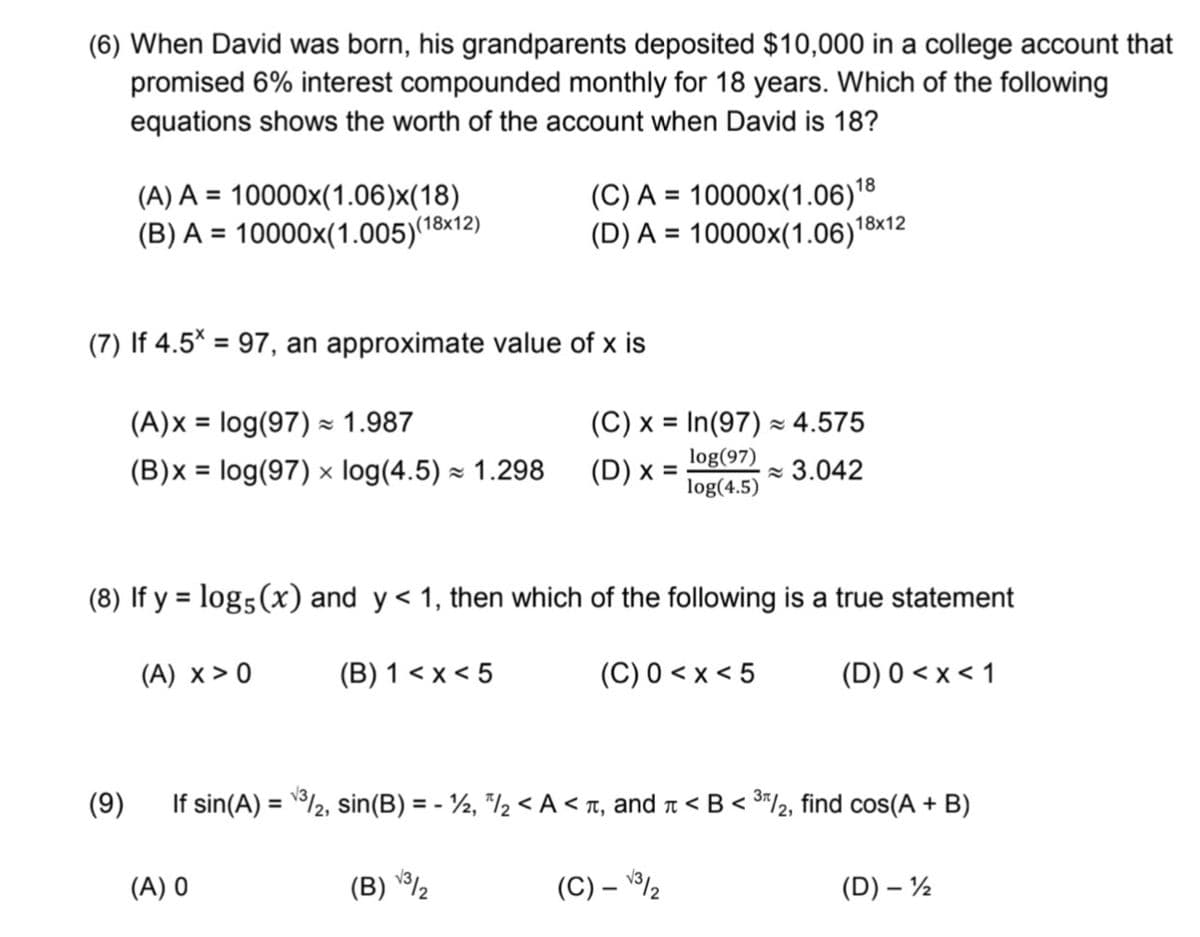(6) When David was born, his grandparents deposited $10,000 in a college account that promised 6% interest compounded monthly for 18 years. Which of the following equations shows the worth of the account when David is 18? (C) A = 10000x(1.06)18 (D) A = 10000x(1.06)® (A) A = 10000x(1.06)x(18) %3D 18x12 (B) A = 10000x(1.005)(18×12) %3D
(6) When David was born, his grandparents deposited $10,000 in a college account that promised 6% interest compounded monthly for 18 years. Which of the following equations shows the worth of the account when David is 18? (C) A = 10000x(1.06)18 (D) A = 10000x(1.06)® (A) A = 10000x(1.06)x(18) %3D 18x12 (B) A = 10000x(1.005)(18×12) %3D
Chapter6: Exponential And Logarithmic Functions
Section6.1: Exponential Functions
Problem 68SE: An investment account with an annual interest rateof 7 was opened with an initial deposit of 4,000...
Related questions
Question

Transcribed Image Text:(6) When David was born, his grandparents deposited $10,000 in a college account that
promised 6% interest compounded monthly for 18 years. Which of the following
equations shows the worth of the account when David is 18?
(A) A = 10000x(1.06)x(18)
(18x12)
(B) A = 10000x(1.005)"
(C) A = 10000x(1.06)18
(D) A = 10000x(1.06)"ª
%3D
%3D
18x12
%3D
(7) If 4.5* = 97, an approximate value of x is
(A)x = log(97) 1.987
(B)x = log(97) × log(4.5) × 1.298
(C) x = In(97) × 4.575
%D
log(97)
(D) x -
z 3.042
log(4.5)
(8) If y = log5(x) and y < 1, then which of the following is a true statement
%3D
(A) x > 0
(B) 1 < x < 5
(C) 0 < x < 5
(D) 0 < x < 1
(9)
If sin(A) = /2, sin(B) = - ½, "/½ < A < r, and r < B < 3*/2, find cos(A + B)
%3D
(A) 0
(B) 2
(C) – /2
(D) – ½
Expert Solution
This question has been solved!
Explore an expertly crafted, step-by-step solution for a thorough understanding of key concepts.
This is a popular solution!
Trending now
This is a popular solution!
Step by step
Solved in 2 steps

Recommended textbooks for you


Algebra for College Students
Algebra
ISBN:
9781285195780
Author:
Jerome E. Kaufmann, Karen L. Schwitters
Publisher:
Cengage Learning

Intermediate Algebra
Algebra
ISBN:
9781285195728
Author:
Jerome E. Kaufmann, Karen L. Schwitters
Publisher:
Cengage Learning


Algebra for College Students
Algebra
ISBN:
9781285195780
Author:
Jerome E. Kaufmann, Karen L. Schwitters
Publisher:
Cengage Learning

Intermediate Algebra
Algebra
ISBN:
9781285195728
Author:
Jerome E. Kaufmann, Karen L. Schwitters
Publisher:
Cengage Learning